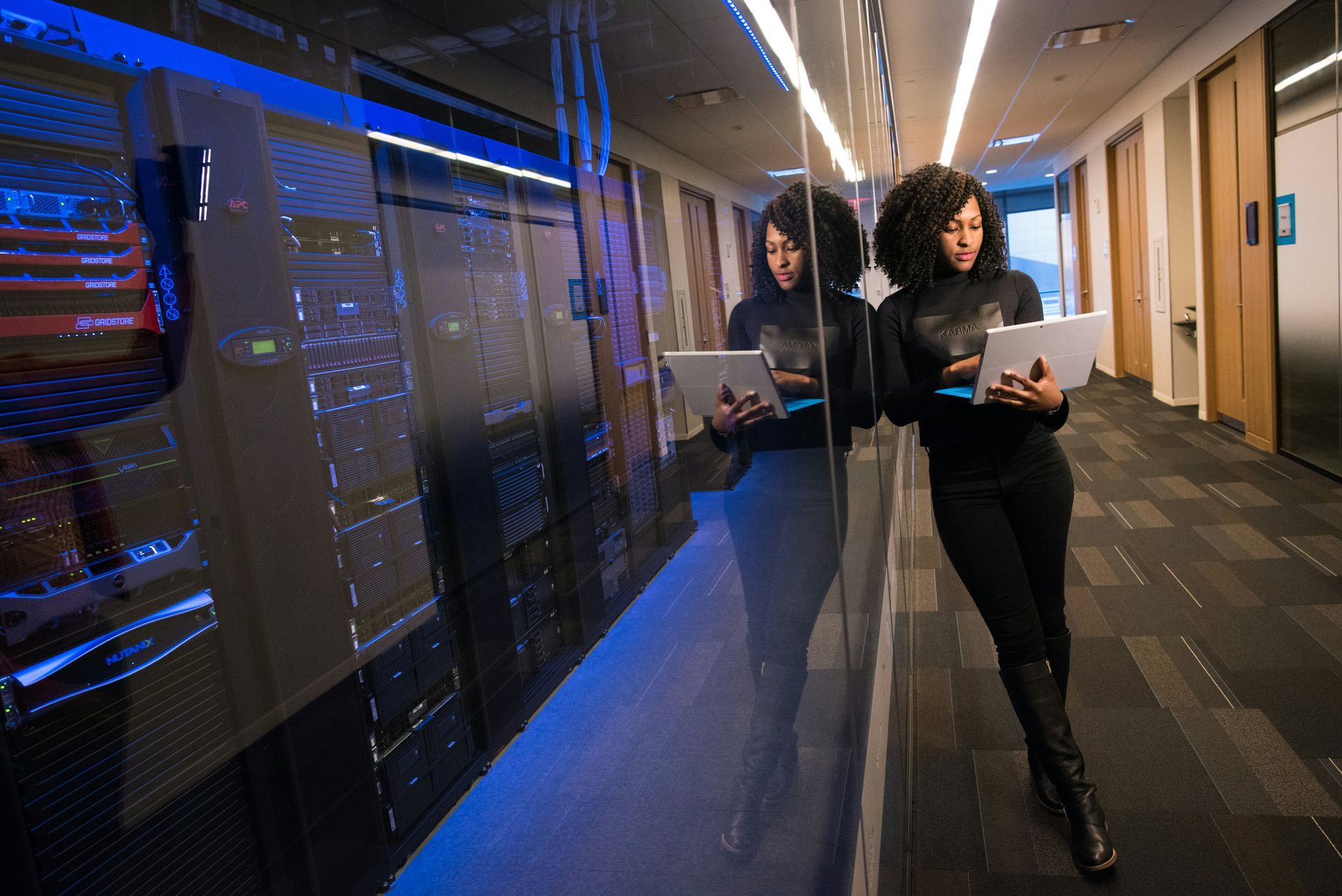Keeping It Real in FMCG – Your Guide to Anti-Counterfeit Solutions
The Battle Against Fakes: Why FMCG Needs Anti-Counterfeit Solutions
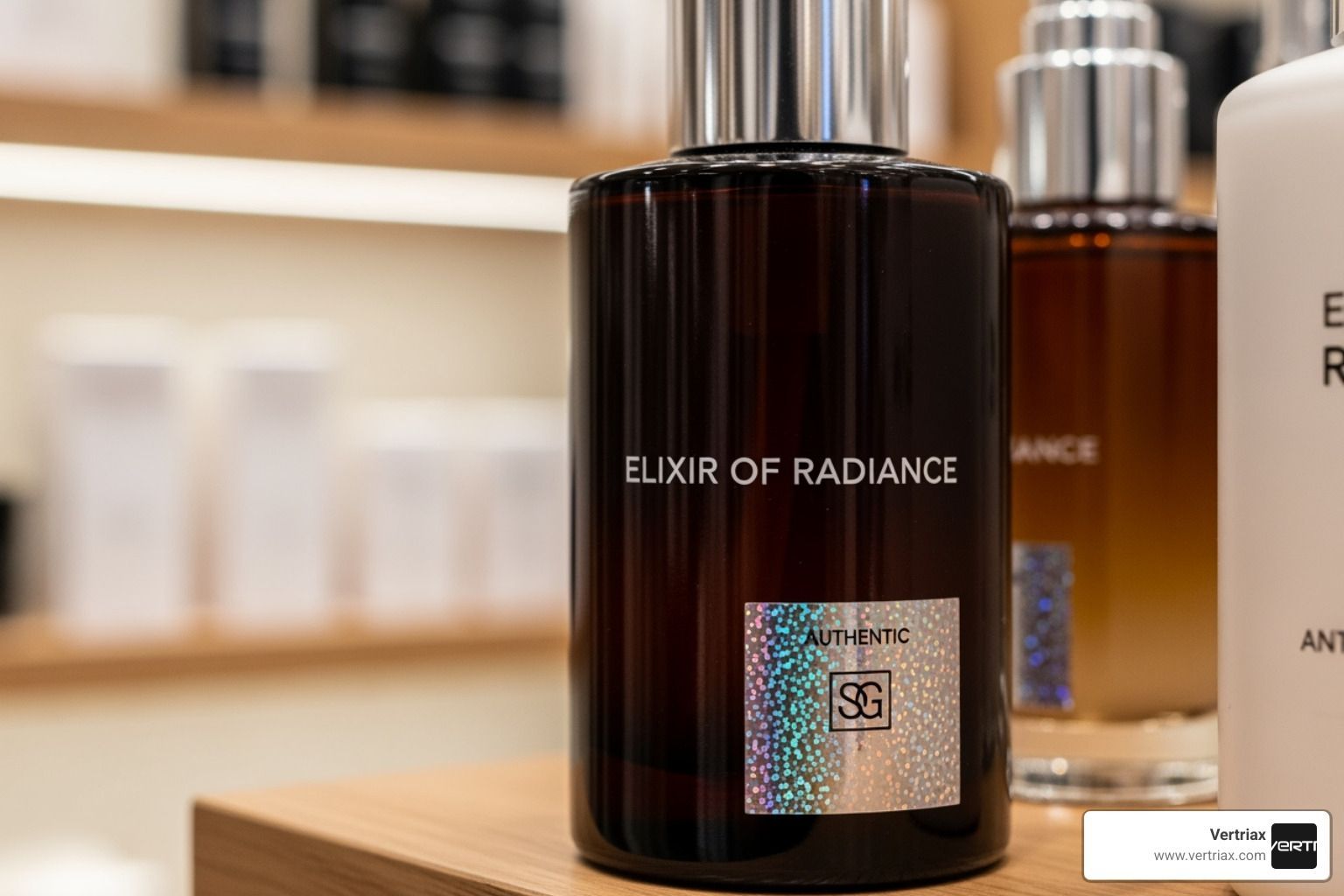
The Fast-Moving Consumer Goods (FMCG) industry faces a serious threat from fake products, making strong anti counterfeit solutions for FMCG industry crucial for survival and success.
Effective anti-counterfeit solutions are essential for FMCG brands to:
- Protect Revenue: The FMCG sector loses about 30% of its business to fakes, a significant financial drain.
- Ensure Consumer Safety: Fake products often contain harmful ingredients, posing serious health risks.
- Safeguard Brand Reputation: Poor-quality fakes erode consumer trust and damage brand loyalty.
- Secure Supply Chains: These solutions help track products and prevent fakes from entering distribution networks.
- Build Consumer Trust: Allowing buyers to verify authenticity boosts their confidence in your brand.
Counterfeiting is a rapidly growing global problem. This guide, drawing on over 28 years of global security experience, will show you how to build proactive defenses to protect your products, profits, and customers.
The Soaring Threat: Understanding the Scale and Impact of FMCG Counterfeiting
The global counterfeit market is a multi-trillion dollar shadow economy that siphons profits and puts consumers at risk. This illicit trade exceeds
$2 trillion annually, with some estimates reaching as high as
$4.5 trillion. This problem has a massive economic impact, causing significant losses and threatening legitimate businesses worldwide.
The Fast-Moving Consumer Goods (FMCG) industry is hit particularly hard, losing an estimated 30% of its business to counterfeit goods. In India, the fake FMCG market is growing at an alarming 44.4% annually, outpacing the legitimate market. This criminal activity also leads to an estimated 2.5 million job losses globally.
The Alarming Numbers
The scale of the problem is staggering:
- Global Counterfeit Trade: A market worth over $2 trillion annually, operating outside of any regulation or taxation.
- FMCG's Heavy Burden: The sector loses roughly 30% of its revenue to fake products, meaning nearly a third of potential sales are lost.
- India's Escalating Crisis: The counterfeit FMCG market is growing at 44.4% annually, highlighting the urgent need for anti counterfeit solutions for FMCG industry in the region.
- Global Job Losses: Counterfeiting is responsible for an estimated 2.5 million lost jobs worldwide.
- Consumer Deception: A shocking 80% of consumers who bought counterfeit FMCG products believed they were genuine, showing the sophistication of modern fakes.
Risks for Brands and Consumers
Fake products create severe dangers for both brands and the public.
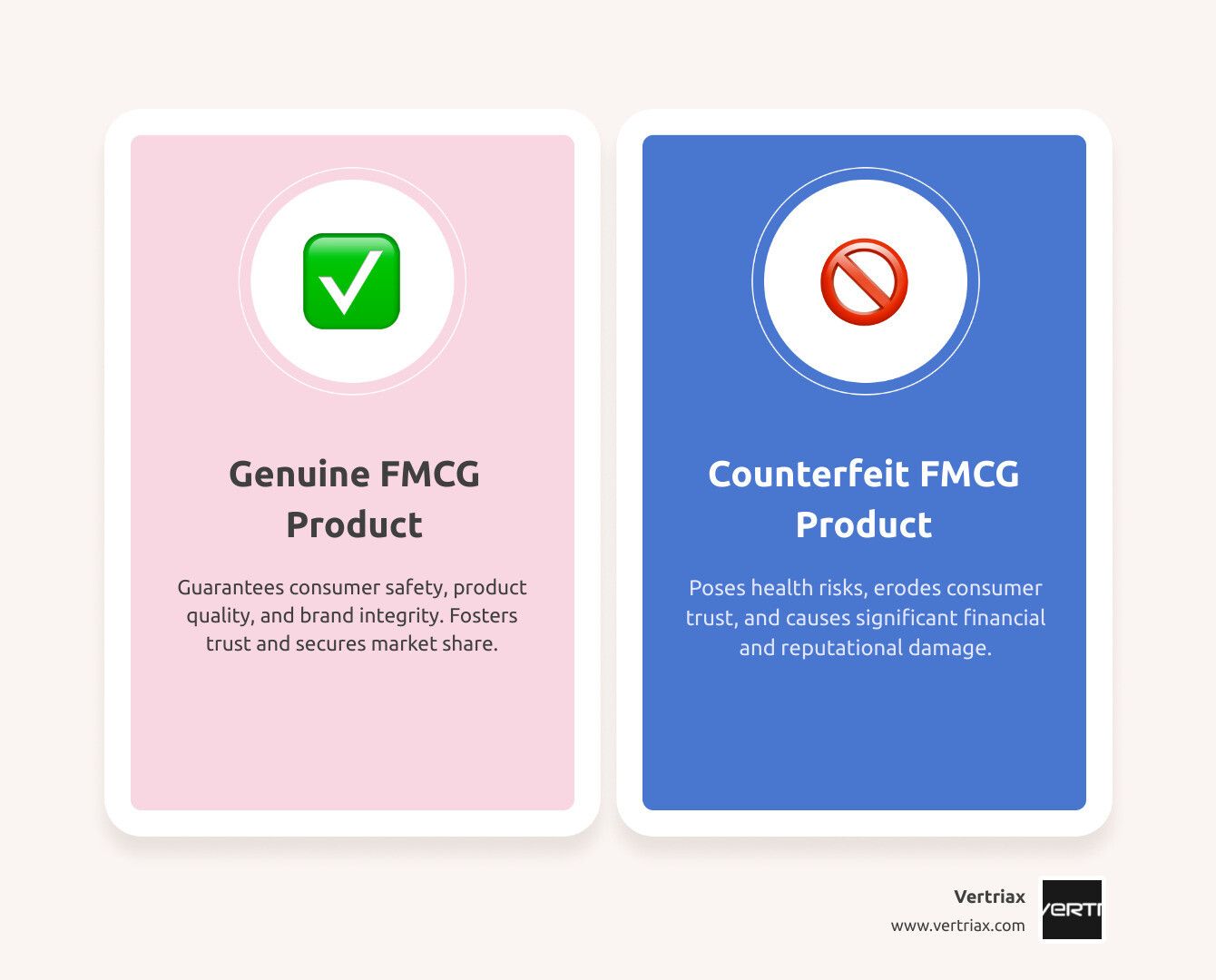
For brands, the consequences include:
- Brand Erosion and Loss of Trust: A bad experience with a fake product is often blamed on the original brand. One study found that 39% of people would lose trust in a brand after encountering a counterfeit.
- Revenue Loss: Direct sales are lost to counterfeiters, draining funds that could be used for innovation and growth.
- Legal Liabilities: Brands can face legal action if counterfeit versions of their products cause harm.
- Supply Chain Disruption: Fakes infiltrating the supply chain create chaos, making it difficult to manage inventory and track authentic goods.
For consumers, the risks are even more dire:
- Health Hazards: Counterfeit food, beverages, and cosmetics often contain harmful or inferior ingredients, leading to illnesses and severe skin reactions. Infamous incidents with fake baby milk powder have affected hundreds of thousands of children.
- Safety Risks: Fake products can be directly dangerous. Counterfeit auto parts, for example, are linked to a significant percentage of road accidents.
- Fatal Consequences: The impact is most horrifying in the pharmaceutical sector, where counterfeit medications are estimated to kill one million people each year. Recent INTERPOL operations highlight the global scale of this deadly trade, with thousands of fake online pharmacies shut down.
Fighting counterfeits is not just a business decision; it's a moral imperative to protect public health and safety.
Why the FMCG Aisle is a Prime Target for Counterfeiters
The very nature of Fast-Moving Consumer Goods (FMCG) makes them an irresistible target for counterfeiters. The combination of
high product volume,
rapid turnover,
complex global supply chains, and consumer
price sensitivity creates a perfect storm for illicit activity. The growth of
e-commerce and the
ease of replication for many FMCG items further increase this vulnerability.
A comprehensive security approach, including robust anti counterfeit solutions for FMCG industry, is vital for brand protection.
Key Vulnerabilities of the FMCG Sector
Counterfeiters exploit several unique characteristics of the FMCG industry:
- High Demand and Turnover: Products fly off the shelves, allowing criminals to move large volumes of fakes quickly and profitably.
- Product Variety and Innovation: A constant stream of new products and flavors makes it difficult for consumers to spot fakes.
- Globally Recognized Branding: Criminals piggyback on the reputations of trusted household names to deceive consumers.
- Complex Distribution Systems: Products change hands many times, creating numerous opportunities for counterfeits to enter the supply chain.
- Variable Regulation: Inconsistent monitoring and regulations across different regions create loopholes for counterfeiters.
- Online Marketplaces and Discounting: E-commerce provides anonymous sales channels, while a culture of heavy discounting can make suspiciously low prices seem legitimate.
The Counterfeiter's Playbook
To get their fakes to market, counterfeiters use a variety of tactics:
- Imitation Packaging: They create sophisticated copies of brand logos, designs, and packaging, making fakes difficult to distinguish from genuine products.
- Diluted Products: For liquids like beverages or cleaning supplies, they mix a small amount of the original product with cheaper, often unsafe, substitutes.
- Refilling Genuine Containers: Criminals collect and refill empty, authentic containers with fake or diluted contents, making the product appear genuine from the outside.
- Look-Alike Branding: They create products with names and logos that are confusingly similar to well-known brands to trick consumers.
- Unauthorized Overruns: A legitimate factory produces more units than ordered by the brand and sells the excess through illicit channels.
- Grey Market Diversion: Genuine products are sold through unauthorized distributors, often across borders, which undermines a brand's control and can lead to quality issues.
Understanding these tactics is the first step in building effective
anti counterfeit solutions for FMCG industry.
A Multi-Layered Defense: Your Guide to Anti-Counterfeit Solutions for the FMCG Industry
Protecting your brand from counterfeiters requires a multi-layered security approach, not a single solution. This strategy combines product authentication, supply chain security, and digital tools to create a robust defense. Together, these elements form powerful
anti counterfeit solutions for FMCG industry brands.
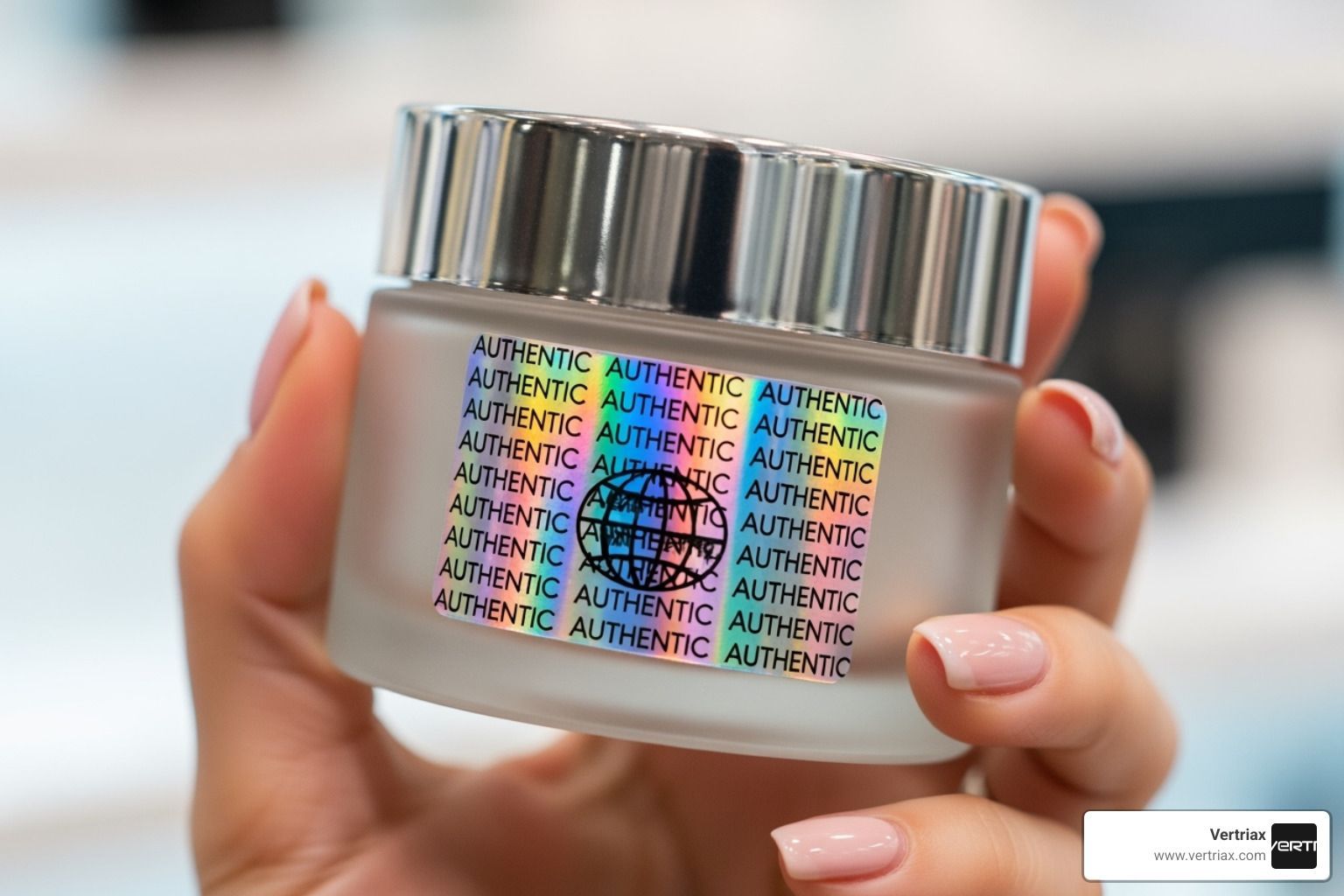
Effective security is about building proactive defenses into your operations. Vertriax helps organizations weave these solutions together seamlessly, ensuring your security tech is both effective and straightforward, allowing you to protect your brand with confidence.
Overt, Covert, and Forensic: A Comparative Look
Anti-counterfeiting features fall into three categories. A strong strategy combines elements from all three.
| Feature Type | Visibility | Verification Method | Security Level | Cost (Relative) |
|---|---|---|---|---|
| Overt | Visible | Naked eye, simple tools (magnifying glass, UV light) | Low to Moderate | Low to Medium |
| Covert | Invisible | Proprietary device, specialized scanner, smartphone app | Moderate to High | Medium to High |
| Forensic | Invisible | Specialized lab equipment, molecular analysis | Very High | High |
- Overt Solutions: These are visible features like holograms, color-shifting inks, and anti-tampering seals. They offer a quick visual check for consumers but can sometimes be copied by sophisticated counterfeiters.
- Covert Solutions: Hidden features like microtext or UV/infrared inks require a special tool or app to verify. They are much harder to replicate, offering a higher level of security.
- Forensic Solutions: These are the most secure features, such as molecular markers or DNA-based taggants, embedded in the product or packaging. They are impossible to copy and require lab analysis for verification, making them ideal for legal evidence.
Combining these layers—for example, an overt hologram for consumers, a covert code for distributors, and a forensic marker for legal proof—creates a formidable defense.
Digital Solutions: Connecting Products, Brands, and Consumers
Digital technology offers powerful new
anti counterfeit solutions for FMCG industry, enabling instant authentication and supply chain visibility.
- Serialized QR codes: Each product gets a unique code that consumers can scan with a smartphone to verify authenticity instantly. This makes each item traceable and difficult to fake.
- NFC tags: These small, embedded chips allow for tap-to-authenticate verification with a smartphone, offering a secure and user-friendly experience.
- Blockchain for traceability: This technology creates a transparent, unchangeable digital ledger of a product's journey from factory to shelf, making it extremely difficult for fakes to enter the supply chain undetected.
- Smartphone authentication: The widespread use of smartphones empowers consumers to verify products themselves, building trust and engagement.
- Real-time data analytics: Digital solutions provide valuable data on when and where products are scanned, helping brands detect suspicious activity like product diversion.
- Consumer engagement: These digital touchpoints can be linked to loyalty programs or rich product information, turning a security feature into a marketing tool.
From Strategy to Execution: Implementing and Benefiting from Anti-Counterfeit Measures
Implementing anti counterfeit solutions for FMCG industry requires strategic planning but is a crucial investment in your brand's future. The return on investment—from recovered revenue, protected reputation, and increased consumer trust—far outweighs the cost. The cost of inaction is often much higher.
Vertriax makes security solutions practical and achievable. Our security consulting services help you build a proactive defense custom to your specific needs.
Integrating Solutions into Your Production and Supply Chain
A primary concern for FMCG brands is integrating security features without disrupting high-speed production lines.
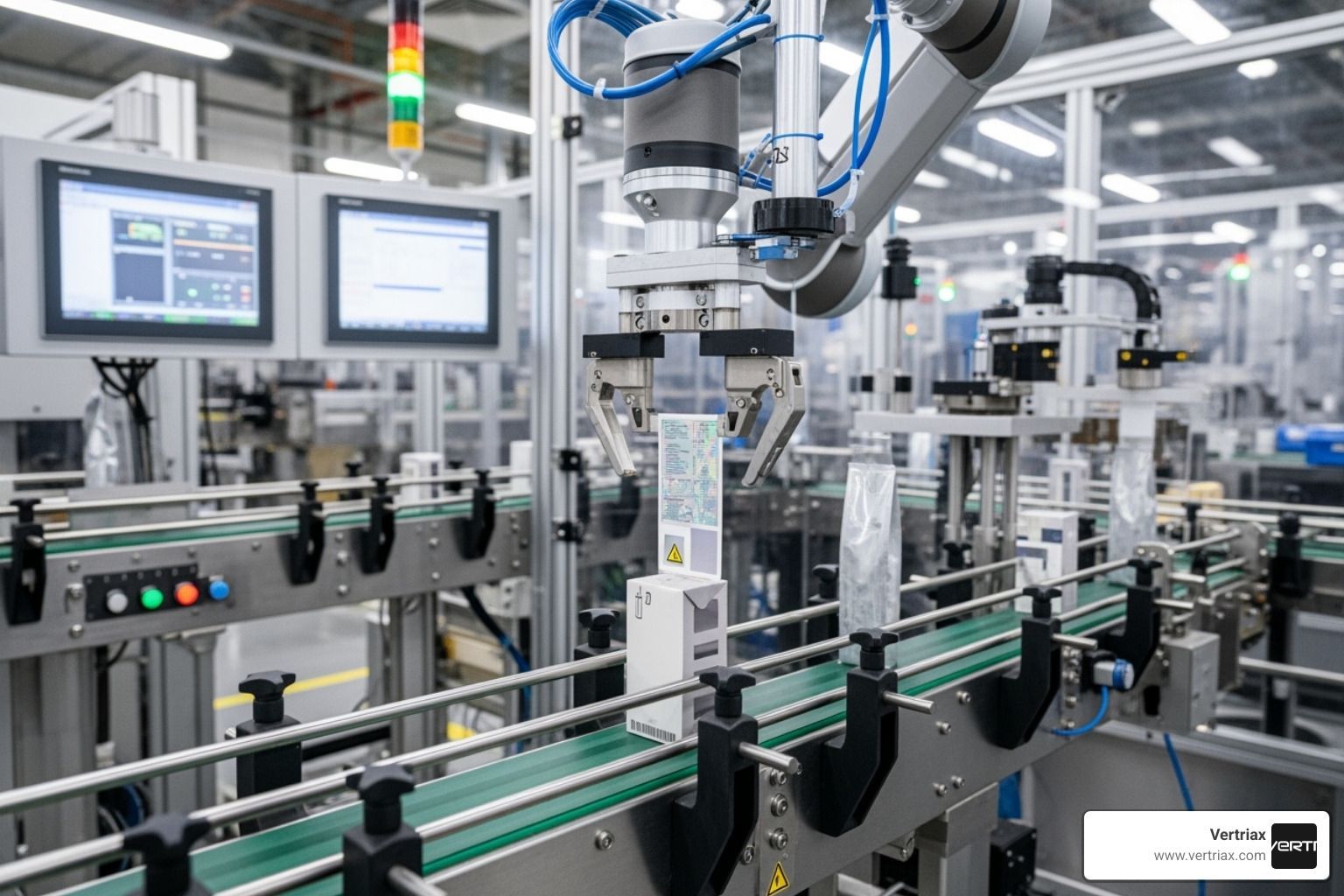
Modern solutions are designed for seamless integration, often with minimal process changes. Some covert solutions can even be added to packaging artwork with zero capital expenditure. Key steps include:
- Apply features at the source: Adding unique identifiers on the production line ensures every product is traceable from creation.
- Collaborate with partners: Work closely with your printers, packagers, and suppliers to ensure they can implement the technology effectively.
- Manage data: Integrate tracking systems with your existing ERP and logistics platforms for end-to-end supply chain visibility.
Choosing the Right Anti-Counterfeit Solution for Your FMCG Brand
Selecting the right
anti counterfeit solutions for FMCG industry means finding the best fit for your specific products, risks, and budget. Key considerations include:
- Risk Assessment: Identify which products are most targeted and where your supply chain is weakest. A professional security assessment can pinpoint these vulnerabilities.
- Product Type: The solution should match the product. A premium cosmetic may warrant forensic markers, while a low-cost snack might be better served by a scalable QR code system.
- Market Analysis: Consider regional regulations and consumer technology adoption.
- Budget and ROI: Look beyond upfront costs to the long-term return on investment from recovered revenue and protected brand value.
- Scalability: Ensure the solution can handle your production volume and expand with your business.
- Ease of Verification: The solution must be easy for consumers and partners to use. Smartphone-based authentication is often ideal.
The Role of Consumer Awareness and Participation
Consumers can be your most powerful allies against fakes. Empowering them with the right tools and knowledge turns them into brand protectors.
- Easy Verification: Provide simple ways for consumers to check authenticity, such as scanning a QR code with a smartphone app. This builds immense trust.
- Educational Campaigns: Inform consumers about the dangers of fakes and how to identify genuine products.
- Incentivize Participation: Link authentication with loyalty programs or rewards to encourage verification.
- Feedback Channels: Make it easy for consumers to report suspected fakes, providing you with valuable intelligence.
By involving consumers, you build deeper brand trust and loyalty.
Frequently Asked Questions about Anti-Counterfeit Solutions in FMCG
Here are answers to common questions FMCG brands have when exploring anti-counterfeiting options.
How much do anti-counterfeit solutions cost for high-volume FMCG products?
Anti counterfeit solutions for FMCG industry are more affordable than many brands assume.
- Cost per unit: Typically ranges from fractions of a cent to a few cents. For high-volume products, this is a tiny fraction of the total cost.
- Scalability: Costs per unit decrease significantly with higher production volumes.
- Return on Investment (ROI): The investment is easily justified by recovered revenue, protected brand reputation, and avoided recall costs. The cost of inaction—including lost trust and potential lawsuits—is far greater. Many modern solutions also require zero capital expenditure.
Can a single solution stop all counterfeiting?
No single solution is foolproof. The most effective defense is a
multi-layered approach that combines different technologies.
- Layered Defense: Use a mix of physical and digital solutions. For example, a visible hologram (overt) can deter casual fakers, while a hidden QR code (covert/digital) provides verifiable proof of authenticity.
- Evolving Threats: Counterfeiters constantly adapt, so your strategy must too. This requires continuous monitoring and regular updates to your security features.
- Strategy is Key: A comprehensive security framework is more important than any single technology. Expert guidance is crucial to stay ahead of threats.
What are the different types of anti-counterfeit solutions for the FMCG industry?
There is a wide array of
anti counterfeit solutions for FMCG industry, which can be combined for maximum effect:
- Physical Features: These are visible or tactile elements like holograms, secure inks (UV, color-shifting), tamper-evident seals, and microtext.
- Digital Codes and Tags: These enable smartphone authentication and include serialized QR codes, NFC tags, and RFID tags for inventory management.
- Supply Chain Technologies: Solutions like blockchain and track and trace systems provide end-to-end visibility and secure the product's journey from factory to consumer.
- Forensic Markers: The highest level of security, these include molecular or DNA-based taggants embedded in the product. They are invisible and require lab analysis, providing irrefutable proof for legal action.
Conclusion: Securing Your Brand's Future in a Complex Market
The counterfeiting crisis is a growing threat to the FMCG industry, draining revenue and endangering consumers. With the global counterfeit trade valued at over $2 trillion and the FMCG sector losing 30% of its business to fakes, inaction is not an option. This is a battle for consumer trust, safety, and your brand's integrity.
The vulnerabilities of the FMCG sector—from high volume and rapid turnover to complex supply chains—are actively exploited by sophisticated criminals. The solution is a proactive, multi-layered defense strategy. By combining overt, covert, and forensic technologies with powerful digital solutions like serialized QR codes and blockchain, you can create a formidable barrier against fakes.
Consumer empowerment is a critical part of this strategy. Giving customers easy-to-use tools to verify product authenticity turns them into brand advocates and builds lasting trust.
At Vertriax, our expertise in security operations and systems management allows us to build comprehensive security frameworks that protect your brand with strategic thinking and operational excellence. Protecting your brand integrity ensures customers receive the safe, genuine products they expect.
An investment in robust
anti counterfeit solutions for FMCG industry is an investment in your future. Don't wait for counterfeiters to damage your reputation. Take control and protect your brand with robust product integrity strategies to secure your place in the market.

